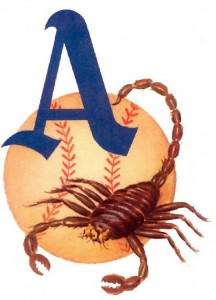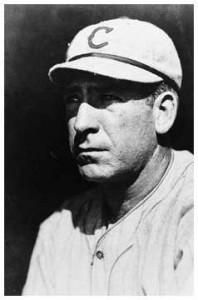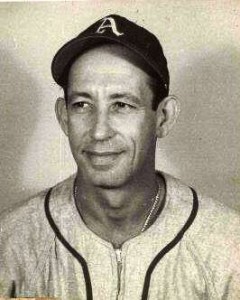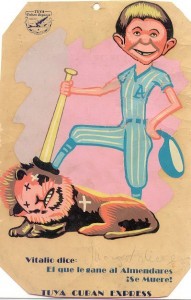Some authors suggest that the creation of the Almendares club dates from 1874, when the influence of baseball activity began to mold the character of the Cubans.
There is no security on this claim, however, is a proven fact that in 1878 was officially organized on the Almendares BBC in order to participate in the first tournament in Cuba that began in December of that year.
The blue team had its first headquarters in the old neighborhood Tulip (where today is located the approximate area of the park that limit Lugareño streets, Luaces, Almendares and Bruzón).
It is said that more refined class of Havana society had, from the outset, a certain inclination towards the band of sky-blue flag. But in no way this event marked counterproductive situations, violent or unpleasant nonetheless covered the aristocratic whiff Alacranes.
The Almendaristas failed to reach the prize of the League in its first filing and, after serious disagreements with the directors of Havana, disappeared after dropping the curtains of the second championship of 1878-79. Then reorganized in better shape for the campaign of 1882-83, but still, the first title eluded them for many more seasons.
To its credit, the target honored to be the first to deal a TEAM hit zero, zero in winter ball career, thanks to the arm of the young Carlos Macia. The talented pitcher Argollo nine innings to Carmelita, on February 13, 1887.
From that romantic stage, the highest recognition it has the unfortunate Oscar Conill, who was consecrated in body and soul to the reorganization of the cast in 1889. Conill worked tirelessly to present a competent squad brought joy to many fans of the standard indigo, but failed to adhere the laurel of the champions to the battle of 1893-94.
A new age
If the nineteenth century proved unproductive in terms of titles are concerned, the twentieth was the opposite. In 1905, and in full professional career, the ninth harvested the first pennant of the new century off the nose of Havana and Fe, with 19 victories and 11 defeats.
Abel Linares, the man who had made the decisions leading from the dock so far, only stayed one more season as manager. But in the years following Eugenio Santa Cruz, Juan L. Sanchez and Alfredo Cabrera, from the bridge, and Joseph C. Mendez, Cristobal Torriente, Gervasio Gonzalez and Armando Marsans, among many others, from the field, added six titles.
The second Almendares Park
Built on land that was built after the current bus station, the new Almendares Park was opened in the 1918-19 season. It was the opening of a new era and the arrival of Adolfo Luque to your computer.
“The Perfect Havana” simultaneous estelarísima quality between the pitcher and the bridge. In the arena of 1919-20 won 10 games, completed 9, lost only 4 and pocketed the first flag as leader of a personal total of eight, seven of which ended up behind the glass of the box in three different decades Almendares .
Today the figure of Adolfo Luque can be seen as emblematic of the club’s history as the same scorpion or blue banner.
Who beat the Almendares dies
When in 1944 the engineer Mario Mendoza became president of the organization, the Scorpions had accumulated a respectable story that much more enriched with the support of the new board, from that moment began to rule the destiny of the whole. Integrated as well, that society, doctors Julio Sanguily, as treasurer, and John Portela, secretary.
It was this last a prodigious time, which played an equivalent role Conrado Marrero, slurries and record holder in ERA during the winter of 1947-48, Fermin Guerra, receiver and manager champion seasons 1948-49 and 1949 – 50 and Roberto Ortiz, leader of the Cuban home run fair in 1949-50.
This natural as far as it relates, because blue coat with several foreigners also experienced tremendous year. Sam Jethroe, for example, was two stolen bases to impose a new record at 49, Rocky Nelson, 55, tied the record for most RBIs Formental Peter and Bobby Bragan, from the cave of decisions, captured 1953-54 and 1954-55 in the last two tournaments in a row won the perennial rival of the Lions in the Cuban League.
Also highlighted as one of the jewels in the crown azure, having won unbeaten in the First Series of the Caribbean, held in the Grand Stadium del Cerro, in February 1949.
For several generations, the motto of “Who beat the Almendares dies,” was extremely popular, because the Scorpions were essential to the enemy bravely opposed the reign of the Lions of Havana.
Sources: DesdeMiPalco/RogerioManzano/InternetPhotos/TheCubanHistory.com
CubanBaseball: Almendares Scorpions/The Cuban History/ Arnoldo Varona, Editor
GO BACK HISTORICAL PAGES OF CUBA
BASEBALL CUBANO: LOS ALACRANES DEL ALMENDARES
Algunos autores señalan que la creación del club Almendares data de 1874, cuando el influjo de la actividad beisbolera comenzaba a moldear el carácter del cubano.
No existe seguridad sobre tal afirmación, en cambio, es un hecho probado que en 1878 se organizó oficialmente el Almendares B.B.C. con el objetivo de participar en el primer torneo de Cuba que se inició en Diciembre de ese año.
El equipo azul tuvo su primera sede en la antigua barriada de Tulipán (donde hoy se ubica el área aproximada del parque que limitan las calles Lugareño, Luaces, Almendares y Bruzón).
Se cuenta que la clase más refinada de la sociedad habanera tuvo, desde un principio, cierta inclinación hacia la banda del pabellón color cielo. Pero, en ningún modo esta eventualidad marcó situaciones contraproducentes, violentas o desagradables, no obstante cubrió a los Alacranes de cierto tufillo aristocrático.
Los almendaristas no pudieron alcanzar el premio de la Liga en sus primeras presentaciones y, luego de serias discrepancias con los directivos del Habana, desaparecieron tras caer las cortinas del segundo campeonato de 1878-79. Luego se reorganizaron en mejor forma para la campaña de 1882-83, pero aún así, el primer título les fue esquivo por muchas temporadas más.
A su favor, el destino los honró en ser el primer quipo en propinar un cero hit, cero carrera en la pelota invernal, gracias al brazo del joven Carlos Maciá. El talentoso pitcher argolló nueve entradas completas al Carmelita, el 13 de Febrero de 1887.
De aquella romántica etapa, el reconocimiento más alto lo tiene el malogrado Oscar Conill, quien se consagró en cuerpo y alma a la reorganización del elenco en 1889. Conill laboró sin descanso para presentar una escuadra competente que aportó muchas alegría a los seguidores del estandarte índigo, pero que no logró ceñirse el laurel de los campeones hasta la contienda de 1893-94.
Una nueva era
Si el siglo XIX resultó improductivo en cuanto a títulos se refiere, el XX fue lo contrario. En 1905, y ya en plena etapa profesional, la novena pescó el primer gallardete de la nueva centuria frente a las narices del Habana y el Fe, con 19 triunfos y 11 reveses.
Abel Linares, el hombre que había tomado las decisiones desde el banquillo de dirigente hasta ese momento, sólo permaneció una campaña más como manager. Pero, en los años siguientes Eugenio Santa Cruz, Juan L. Sánchez y Alfredo Cabrera, desde el puente de mando, y José C. Méndez, Cristóbal Torriente, Gervasio González y Armando Marsans, entre otros muchos, desde el campo de juego, adicionaron seis títulos más .
El segundo Almendares Park
Edificado en los terrenos en que luego se construyó la actual Terminal de Ómnibus, el nuevo Almendares Park quedó inaugurado en la temporada de 1918-19. Fue la apertura de una nueva etapa y la llegada de Adolfo Luque al equipo.
“El Havana Perfecto” simultaneó su calidad estelarísima entre la loma de lanzar y el puente de mando. En la liza de 1919-20 ganó 10 partidos, completó 9, perdió sólo 4 y se embolsilló el primer banderín como dirigente de un total de ocho personales, siete de los cuales fueron a parar tras los cristales de la urna almendarista en tres décadas diferentes.
Hoy la figura de Adolfo Luque se puede considerar tan emblemática en la historia del club como el mismo alacrán o el pendón azul.
El que le gane al Almendares se muere
Cuando en 1944 el ingeniero Mario Mendoza asumió la presidencia de la organización, los Alacranes tenían acumulada una respetabilísima historia que se enriqueció mucho más con el apoyo prestado por la nueva junta directiva que, desde ese instante, comenzó a regir los destinos del conjunto. Integraron además, aquella sociedad, los doctores Julio Sanguily, como tesorero, y Juan Portela, como secretario.
Fue esta última una época pródiga, en la que jugaron un rol equivalente Conrado Marrero, recordista en lechadas y promedio de carreras limpias durante el invierno de 1947-48; Fermín Guerra, receptor y director campeón de las temporadas de 1948-49 y 1949-50 y Roberto Ortiz, líder de los jonroneros cubanos en la justa de 1949-50.
Lo anterior en lo que a naturales se relaciona, porque con la casaca azul varios extranjeros también experimentaron años formidables. Sam Jethroe, por ejemplo, estuvo a dos bases robadas de imponer un nuevo récord en el 49; Rocky Nelson, en el 55, igualó la marca de más carreras impulsadas de Pedro Formental, y Bobby Bragan, desde la caverna de las decisiones, conquistó en 1953-54 y 1954-55 los dos últimos torneos que ganó de forma consecutiva el perenne rival de los Leones en la Liga Cubana.
Además, destaca como una de las joyas más preciadas de la corona azur, el haber triunfado invicto en la Primera Serie del Caribe, efectuada en el Gran Stadium del Cerro, en Febrero de 1949.
Por varias generaciones, la divisa de “El que le gane al Almendares se muere”, fue sumamente popular, porque los Alacranes resultaron el adversario indispensable que se opuso con valor al reinado de los Leones de la Habana.
Sources: DesdeMiPalco/RogerioManzano/InternetPhotos/TheCubanHistory.com
CubanBaseball: Almendares Scorpions/The Cuban History/ Arnoldo Varona, Editor
GO BACK HISTORICAL PAGES OF CUBA








